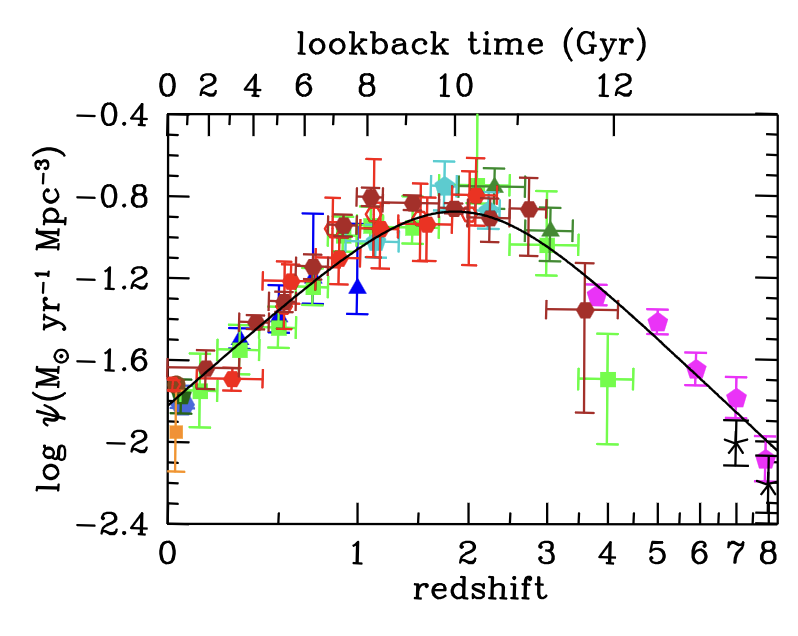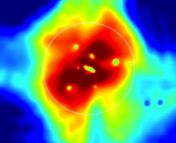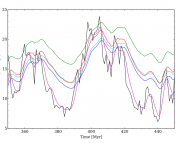Authors: Moritz Haslbauer, Pavel Kroupa, Tereza Jerabkova
First Author’s Institution: University of Bonn
Status: Accepted to MNRAS [closed access]
The cosmological principle, one of the founding assumptions of the standard model of cosmology, states that the Universe is expected to be both homogeneous and isotropic. In other words, no matter how far away you look and in which direction, things should be, statistically, about the same. However, recent observations have begun to complicate this idea, finding large-scale asymmetries and inhomogeneities that challenge the simplicity of the standard model. Today’s authors investigate the idea that our Milky Way galaxy may be located inside one of these large-scale oddities.
Past one hundred thousand parsecs
According to current theories of galaxy evolution across the Universe, star formation begins at “cosmic dawn” sometime in the first 550 million years after the Big Bang. After this, galaxies begin to grow rapidly over time, forming more and more new stars. The star formation rate (SFR) peaks at “cosmic noon”, roughly 2-3 billion years after the Big Bang, and then declines until the present day. This can be summarized in the Lilly-Madau plot pictured in Figure 1, which shows star formation per year per cubic megaparsec as measured from galaxies across a wide range of cosmic time.

Although it’s not possible to measure the star formation history (SFH) of any single galaxy directly, since we can’t make repeated observations over billions of years, we can test the Lilly-Madau model locally by measuring the present-day star formation rates of nearby galaxies and extrapolating backward based on established models of galaxy evolution. Today’s paper sets out to do just that!
Making the grade
The authors consider two possible models for the star formation history of a given galaxy. The first, the “delayed-τ” model, applies to larger galaxies over about 10 billion times the mass of the Sun. These tend to evolve according to the “main sequence” of galaxy evolution; the SFR increases rapidly during the first stages of the galaxy’s life, then peaks and declines until the present day. Smaller, lower-mass galaxies, however, form stars at a much more constant rate, and their star formation histories are therefore described by the second model, a power law.
If the trend of galaxy formation over the entire Universe described by the Lilly-Madau plot also holds for the Local Volume, a region within 11 megaparsecs of the Milky Way, then it should be possible to more or less reproduce the plot shown in Figure 1 using local galaxies. In Figure 2, the authors compare the observed non-local star formation rates from Figure 1 (black) with the projected star formation histories of local galaxies according to the delayed-τ (red) and power law (green) models. They also test a combination of the two models (blue) in which the SFHs of more massive galaxies follow the delayed-τ model, while less massive galaxies follow a power law.

All three models produce estimated star formation histories for the Local Volume that are very different from the overall picture of galaxy evolution in the Universe; local galaxies seem to have much more constant SFRs than the galaxies in Figure 1, no matter which model is used to estimate their histories. A constant star formation history indicates a smaller galaxy, so the authors argue that galaxies in the Local Volume must be smaller than the Universal average.
The galaxies look very different today
Although more observations are needed to confirm this, the data seems to indicate a statistically significant difference between the density of the Local Volume and the Universe as a whole. The authors put forth several possible explanations for this phenomenon. First, while unlikely, it’s possible that there exists a systematic error in our measurements; either of star formation rates in the Local Volume or outside it, or both. Secondly, the models of galaxy evolution used to estimate the star formation histories of nearby galaxies could be inadequate, although they are well established in the literature.
The more intriguing explanations involve large-scale inhomogeneities in the density of the Universe. Prior work has shown that the Local Volume is part of a void whose size may contradict standard cosmological predictions, and the result of today’s paper corroborates the idea that local space is underdense.
Alternatively, or perhaps additionally, the star formation rates shown in the Lilly-Madau plot could reflect a faraway overdensity rather than the average star formation history of the Universe. This overdensity would be located around 5 comoving gigaparsecs away from the Milky Way, and would cause the data in Figure 1 to be disproportionately high-mass main-sequence galaxies with respect to the average. Independent evidence also suggests large-scale inhomogeneities in the density of the Universe.
So, our cosmic neighborhood may be a little less crowded than others. Although more evidence is needed to continue to investigate this theory, the implications are exciting; not only would we learn more about the history of galaxies, but we might even be able to resolve the infamous Hubble tension! We can look forward to future data from telescopes like JWST to help us gather precise data about our galactic environment, and outward to the wider Universe.
Astrobite edited by: Yoni Brande
Featured image credit: Pablo Carlos Budassi via Wikimedia Commons




